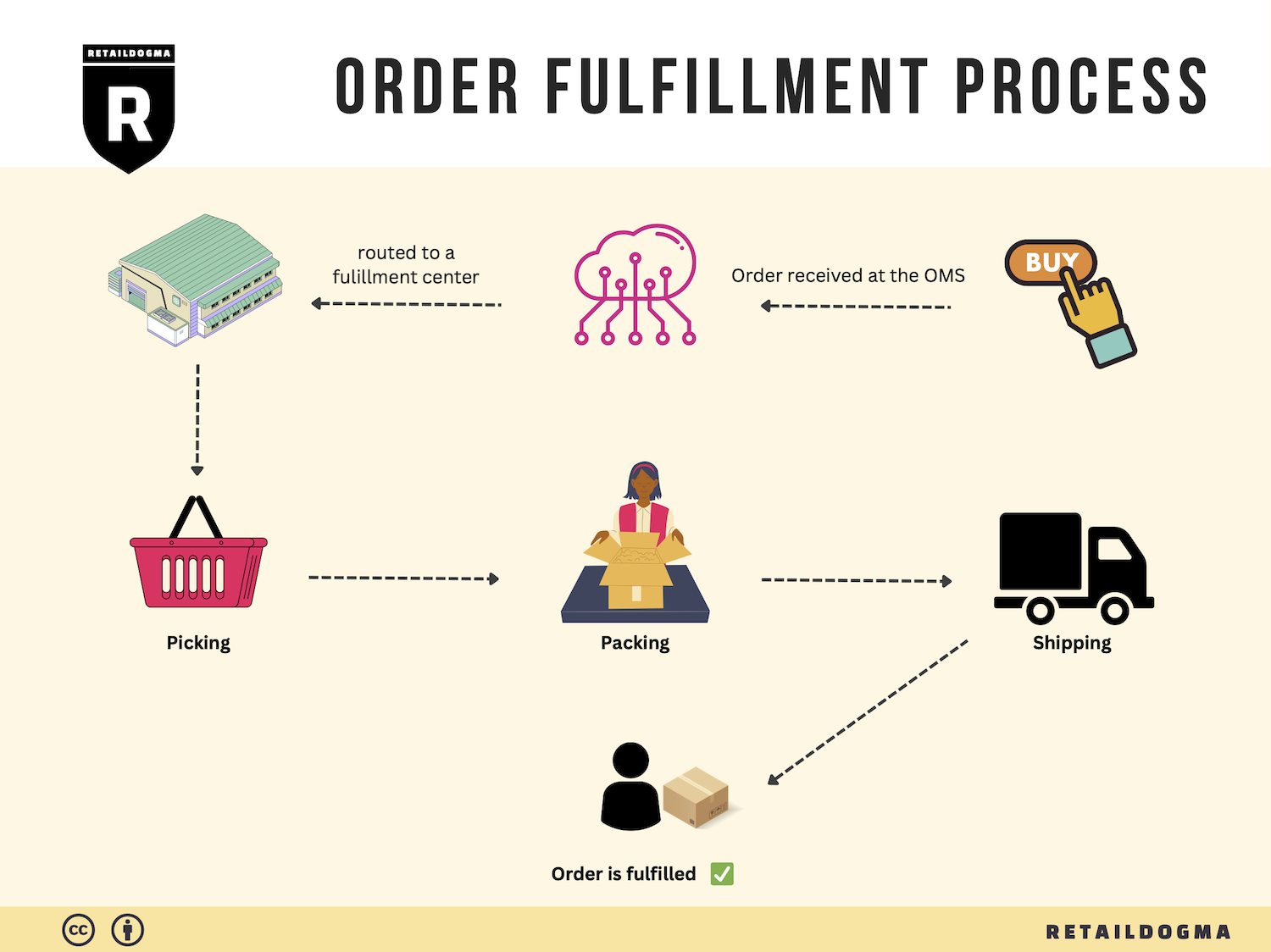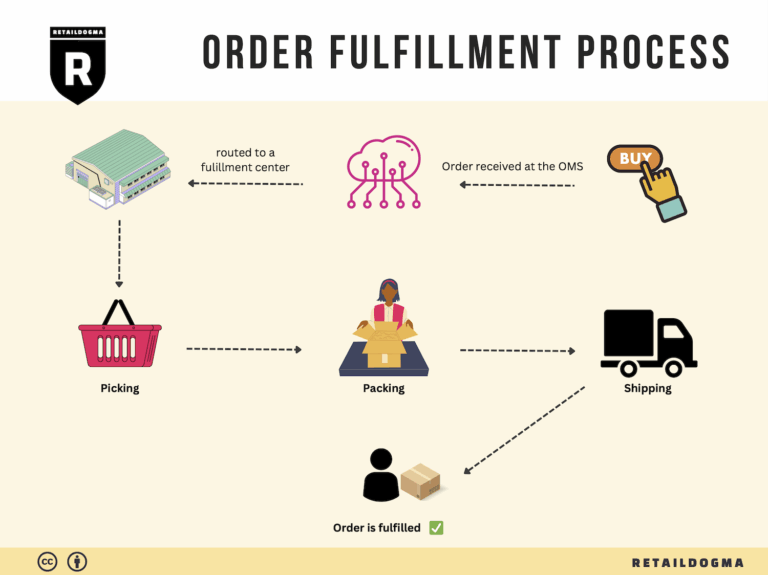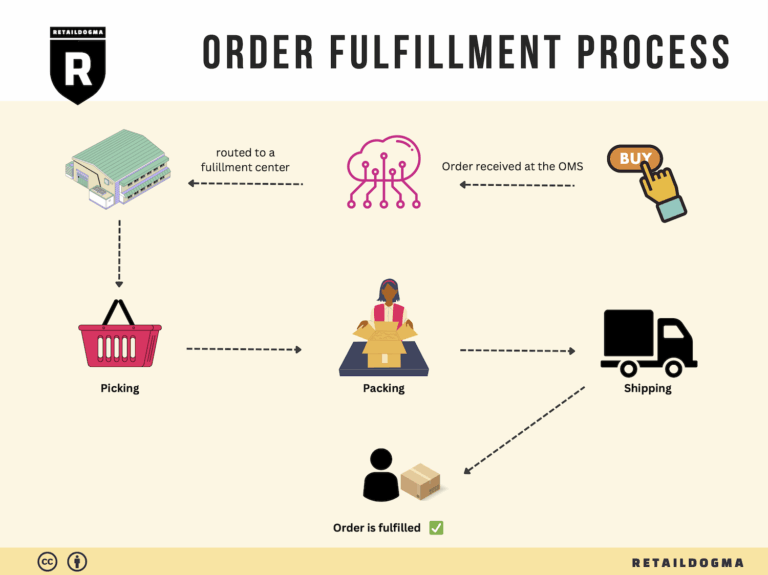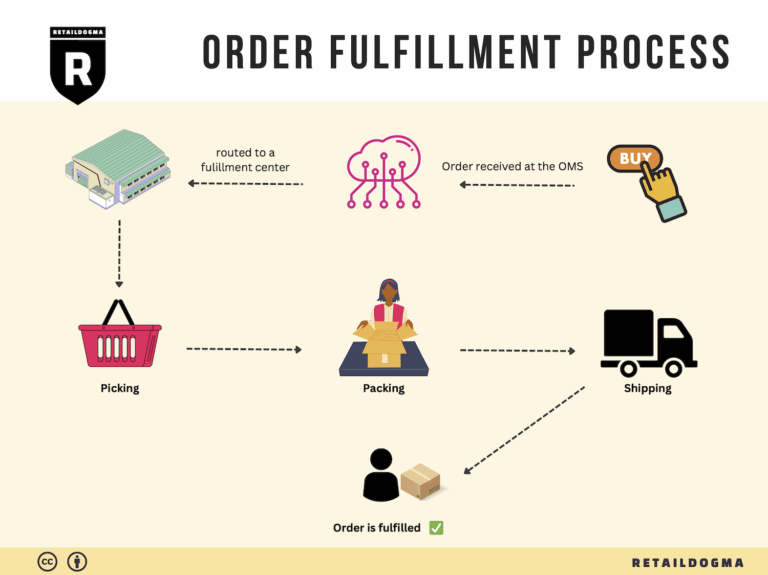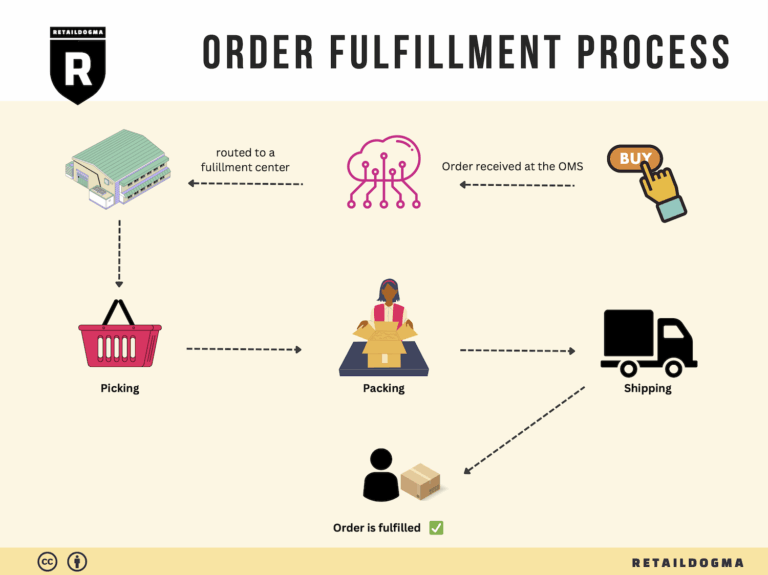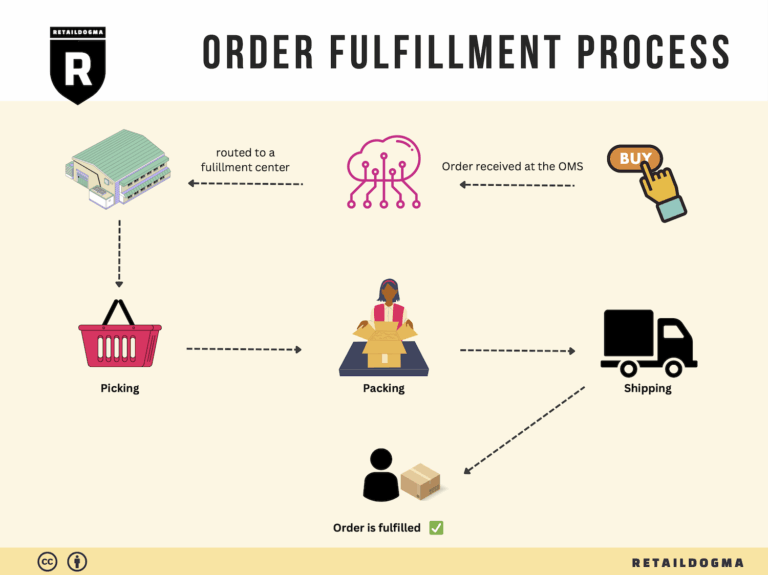Ecommerce Fulfillment Services: The Ultimate Guide (2025)
What is E-commerce Fulfillment? An Introduction for Growing Businesses
Understanding E-commerce Fulfillment
As a growing online business, you’re likely feeling the pressure of managing the packing and shipping of orders. This critical aspect of your operations can quickly become overwhelming, especially as your sales volume increases. The fulfillment process—getting your products into the hands of your customers—can be complex and time-consuming. However, it is also a fundamental part of your business that significantly impacts customer satisfaction and retention.
At its core, e-commerce fulfillment encompasses all the steps involved in delivering a product to a customer after they place an order. This includes everything from inventory management and order processing to picking, packing, and shipping. For many entrepreneurs and operations managers, understanding and mastering this process can be the difference between scaling successfully and facing logistical nightmares.
In this guide, we will explore various e-commerce fulfillment models, such as Third-Party Logistics (3PL) and Fulfillment by Amazon (FBA). Each model has its unique advantages and challenges, and selecting the right one for your business is crucial. We will delve into the core services associated with fulfillment, including inventory management, order processing, and returns handling. Additionally, we will discuss how to choose the right fulfillment partner, highlighting key factors such as service levels, technology integration, and customer support.
Pricing is another critical component of the fulfillment landscape. We will break down common pricing structures and help you understand how to evaluate costs in relation to the services provided. By gaining insights into these aspects, you can make informed decisions that align with your business goals and budget constraints.
Ultimately, the goal of this guide is to empower you—e-commerce business owners, operations managers, and entrepreneurs—to navigate the complexities of logistics with confidence. By providing you with practical advice and actionable insights, we aim to help you streamline your fulfillment processes, enhance your customer experience, and position your business for sustainable growth. Whether you are considering outsourcing your fulfillment or optimizing your existing operations, this guide will serve as a valuable resource in your journey toward logistical excellence.
What You’ll Learn In This Guide
- What is E-commerce Fulfillment? An Introduction for Growing Businesses
- The Order Fulfillment Process: From ‘Buy’ Button to Customer’s Door
- Comparing Fulfillment Models: In-House vs. 3PL vs. Dropshipping
- A Deep Dive into Amazon FBA: Pros, Cons, and Who It’s For
- Core Services Offered by Fulfillment Centers
- How to Choose a Fulfillment Partner: A 6-Point Checklist
- Understanding Fulfillment Pricing: A Breakdown of Common Fees
- Frequently Asked Questions (FAQs) about Fulfillment
- Conclusion: Is Outsourcing Fulfillment the Right Move for Your Business?
- Important Disclaimer
The Order Fulfillment Process: From ‘Buy’ Button to Customer’s Door
1. Receiving Inventory
The order fulfillment process begins with receiving inventory into the warehouse. When products arrive from suppliers, they must be checked for accuracy and quality. This step involves verifying that the received items match the purchase order in terms of quantity and specifications.
It’s essential to maintain a high level of accuracy during this phase to prevent discrepancies that can lead to inventory shortages or excess. Key terms like SKU (Stock Keeping Unit) come into play here. Each product should be assigned a unique SKU that helps in tracking and managing inventory effectively. By ensuring that all incoming goods are logged accurately into your inventory management system, you establish a solid foundation for the subsequent steps in the fulfillment process.
2. Warehouse Storage
Once inventory is received and checked, it is moved into warehouse storage. This step involves organizing products in a way that maximizes efficiency and minimizes retrieval time. Proper storage techniques, such as using FIFO (First In, First Out) methods, ensure that older stock is sold first, which is particularly important for perishable items.
Effective warehouse storage not only improves inventory management but also enhances the overall efficiency of the fulfillment process. By categorizing products based on their SKUs and using labeling systems, employees can quickly locate items when an order is placed. This organization is crucial for meeting customer expectations regarding delivery times and order accuracy.
3. Order Picking
When a customer places an order, the next step is order picking. This process involves retrieving the correct items from storage based on the order details. Utilizing pick lists, which outline the items needed for each order, helps streamline this process.
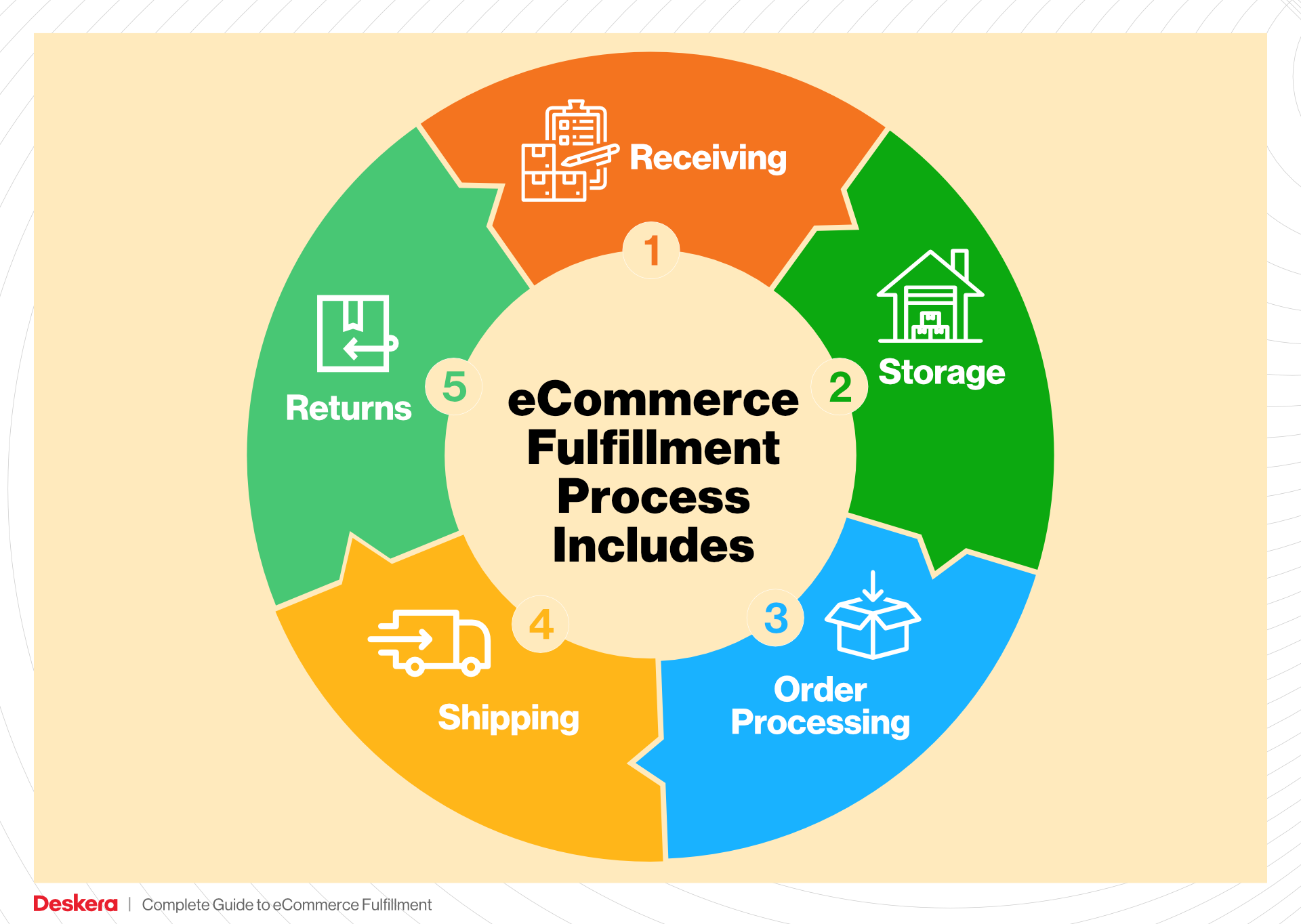
Efficient order picking is vital as it directly impacts order accuracy and speed. Different picking methods, such as batch picking or zone picking, can be employed depending on the volume of orders and warehouse layout. The faster and more accurately you can pick items, the more satisfied your customers will be. This step is where operational efficiency can significantly influence your overall fulfillment success.
4. Order Packing
After items are picked, they move to the order packing stage. This is where products are carefully packed for shipment. Proper packing is not just about placing items in a box; it involves selecting the right packaging materials to protect products during transit while also considering cost-effectiveness.
Key considerations include using appropriate packaging inserts and ensuring that the items are secure within the box to prevent damage. This step is crucial because well-packed orders reduce the likelihood of returns due to damage, ultimately saving costs and enhancing customer satisfaction. Moreover, including branding elements in the packaging can improve the overall customer experience and promote brand loyalty.
5. Shipping & Delivery
The final step in the fulfillment process is shipping and delivery. Once an order is packed, it is labeled and scheduled for shipment through an appropriate carrier. This stage is critical as it determines how quickly and efficiently the order reaches the customer.
Utilizing multi-carrier rate shopping allows businesses to select the best shipping options based on cost and delivery speed, thus optimizing the overall shipping experience. Providing customers with tracking information enhances transparency and keeps them informed about their order status. Efficient shipping processes not only improve customer satisfaction but also play a significant role in repeat business and overall brand reputation.
In conclusion, each step of the order fulfillment process is interconnected and plays a vital role in ensuring a seamless experience for customers. From receiving inventory to shipping and delivery, attention to detail and operational efficiency can significantly impact your e-commerce business’s success. Implementing effective practices at each stage will help scale your operations while maintaining high standards of customer service.

Comparing Fulfillment Models: In-House vs. 3PL vs. Dropshipping
Fulfillment Models Overview
When scaling an e-commerce business, choosing the right fulfillment model is crucial for operational efficiency, customer satisfaction, and overall growth. The three predominant models—In-House Fulfillment, Third-Party Logistics (3PL), and Dropshipping—each come with distinct characteristics, advantages, and challenges. Below is a comparative analysis of these models.
| Model | Who Handles Inventory | Best For (Business Stage) | Key Advantage | Key Disadvantage |
|---|---|---|---|---|
| In-House Fulfillment | The business itself | Established businesses with stable demand | Full control over inventory and fulfillment processes | High overhead costs and resource allocation required |
| Third-Party Logistics (3PL) | A specialized logistics provider | Growing businesses looking to scale | Access to advanced logistics technology and expertise | Less control over the fulfillment process |
| Dropshipping | Suppliers or manufacturers | Startups and businesses with limited capital | Low startup costs and no inventory management | Lower profit margins and potential supplier reliability issues |
In-House Fulfillment
In-house fulfillment refers to when a business manages its own warehousing, inventory, and shipping operations. This model is often employed by established businesses that have a steady demand for their products and the resources to maintain a fulfillment center. The key advantage of in-house fulfillment lies in the complete control it offers over inventory management, shipping times, and customer service. Businesses can tailor their processes to their unique needs, ensure quality control, and maintain direct oversight of their logistics operations.
However, this model also presents significant challenges. The initial investment in warehousing space, staffing, and technology can be substantial, leading to high overhead costs. Additionally, businesses must allocate resources to manage logistics, which can divert attention from core activities like marketing and product development. As demand fluctuates, businesses may find themselves overstaffed or under-resourced, affecting their overall efficiency.
Third-Party Logistics (3PL)
Third-party logistics (3PL) involves outsourcing fulfillment and logistics operations to specialized providers. This model is particularly advantageous for growing businesses that want to scale without the burden of managing their own warehouses. A 3PL partner typically offers a range of services, including inventory management, order processing, shipping, and returns handling. Companies like iDrive Logistics exemplify this model by providing a national network of fulfillment centers, enabling businesses to leverage advanced logistics technology and expertise.
The primary benefit of partnering with a 3PL is the ability to focus on core business functions while leaving logistics to the experts. This model also provides flexibility, allowing businesses to scale their operations up or down based on demand without the associated overhead costs of maintaining an in-house facility. However, a key disadvantage is the reduced control over the fulfillment process. Businesses must rely on their 3PL partners to meet service levels and ensure quality, which can be challenging if the provider does not align with the company’s standards or expectations.
Dropshipping
Dropshipping is a fulfillment model where the retailer does not keep products in stock. Instead, when a customer places an order, the retailer purchases the item from a third-party supplier, who then ships it directly to the customer. This model is particularly appealing for startups and entrepreneurs with limited capital, as it eliminates the need for inventory investment and warehousing costs.
The primary advantage of dropshipping is its low barrier to entry. Retailers can test new products and market trends without the financial risks associated with holding inventory. Additionally, it allows for a wide product range without the logistical challenges of managing stock. However, dropshipping also has notable drawbacks. Retailers often face lower profit margins due to the wholesale pricing of suppliers, and they may encounter issues with supplier reliability, shipping times, and product quality. Furthermore, the lack of inventory control can lead to challenges in managing customer expectations and service levels.
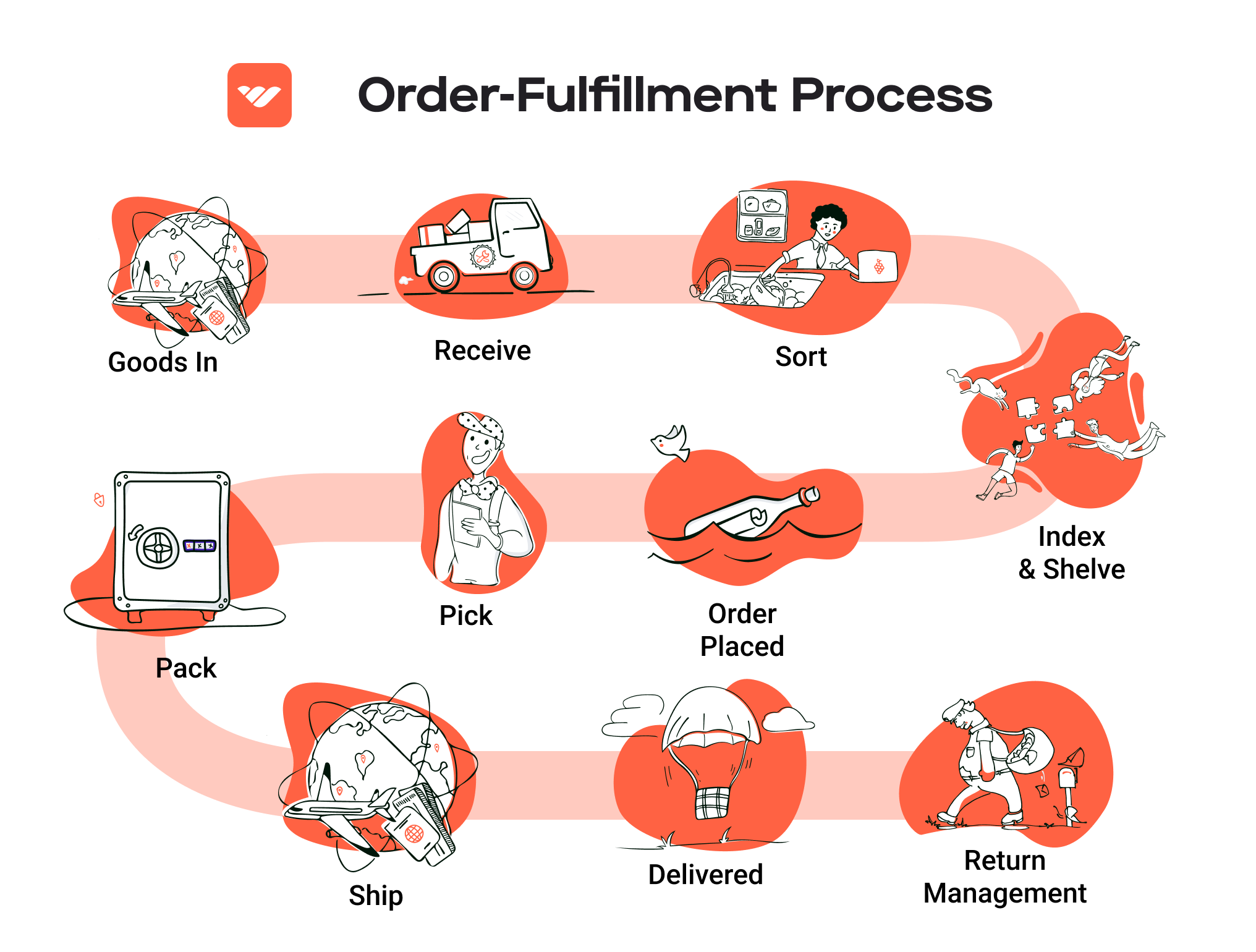
Conclusion
Choosing the right fulfillment model depends on various factors, including business size, growth stage, capital availability, and operational capabilities. In-house fulfillment provides control and customization, 3PL offers scalability and expertise, while dropshipping allows for low-risk entry into the market. E-commerce business owners must assess their specific needs and capabilities to determine which model aligns best with their strategic goals for growth and customer satisfaction.
A Deep Dive into Amazon FBA: Pros, Cons, and Who It’s For
Understanding Fulfillment by Amazon (FBA)
Fulfillment by Amazon (FBA) is a logistics service offered by Amazon that allows sellers to store their products in Amazon’s fulfillment centers. Amazon then takes care of storage, packaging, and shipping the products directly to customers. This service enables sellers to leverage Amazon’s extensive logistics network and customer service capabilities, allowing them to focus on growing their business while Amazon handles the intricacies of order fulfillment.
How FBA Works
-
Setup: Sellers create an Amazon Seller account and enroll in the FBA program. They then prepare their products according to Amazon’s guidelines and ship them to designated fulfillment centers.
-
Storage: Once products arrive at Amazon’s fulfillment centers, they are stored until an order is placed. Amazon uses sophisticated inventory management systems to track stock levels and manage storage efficiently.
-
Order Processing: When a customer places an order for a product listed with FBA, Amazon picks, packs, and ships the item on behalf of the seller. This includes handling customer service inquiries and processing returns.
-
Shipping: Products fulfilled through FBA are eligible for Amazon Prime and other expedited shipping options, which can significantly enhance the customer experience.
-
Returns Management: Amazon also manages returns for FBA products, providing customers with a seamless return process while keeping sellers informed about returns and customer feedback.
Pros of Using FBA
1. Prime Eligibility
One of the most significant advantages of using FBA is that products fulfilled through this service are eligible for Amazon Prime. This can lead to increased visibility and sales, as Prime members are more likely to purchase items that offer free two-day shipping.
2. Customer Trust
Amazon is a trusted brand, and utilizing FBA can enhance a seller’s credibility. Customers often prefer purchasing from FBA sellers due to the perceived reliability and quality of service that comes with Amazon’s fulfillment processes.
3. Multi-Channel Fulfillment
FBA is not limited to Amazon sales. Sellers can use FBA to fulfill orders from other sales channels, such as their own websites or other online marketplaces. This flexibility allows businesses to streamline their operations and manage inventory more efficiently across multiple platforms.
4. Time Savings
By outsourcing logistics to Amazon, sellers can save significant time on order processing, packing, and shipping. This allows them to focus on core business activities such as marketing and product development.
5. Scalability
FBA allows businesses to scale operations without the need for additional warehousing or logistics staff. As order volumes increase, sellers can simply send more inventory to Amazon, leveraging their infrastructure.
Cons of Using FBA
1. High Fees
While FBA provides many benefits, it also comes with costs. Sellers incur fees for storage, order fulfillment, and additional services, which can significantly eat into profit margins. For businesses with lower-priced products, these fees can be a critical factor to consider.
2. Strict Inventory Rules
Amazon has stringent inventory management policies. Sellers must adhere to specific requirements regarding inventory storage and product preparation. Non-compliance can lead to additional fees or even account suspension.
3. Commingling Risks
FBA operates on a commingling model, where inventory from different sellers is mixed in Amazon’s warehouses. This can pose risks, such as the potential for receiving returns that do not belong to the seller or issues with counterfeit products affecting seller reputation.
4. Limited Control
Using FBA means relinquishing some control over the fulfillment process. Sellers cannot directly manage the packing or shipping experience, which can lead to variability in service quality.
5. Long-Term Storage Fees
Amazon charges long-term storage fees for products that remain in fulfillment centers for over a specified period. This can pressure sellers to sell inventory quickly, leading to potential markdowns or loss of profitability on older stock.
Who is FBA Best For?
Fulfillment by Amazon is particularly well-suited for:
-
Small to Medium-Sized Businesses: Companies that lack the resources to manage their logistics can benefit from FBA’s extensive infrastructure.
-
E-commerce Entrepreneurs: New sellers looking to establish a presence on Amazon can leverage FBA to gain trust and visibility quickly.
-
Brands with High Turnover Products: Businesses that sell fast-moving consumer goods (FMCG) can take advantage of FBA to maintain stock levels without worrying about warehousing.
-
Sellers Targeting Prime Members: Brands wanting to attract Amazon Prime customers will find FBA essential, as it directly impacts customer purchasing decisions.
-
Multi-Channel Sellers: Those selling on multiple platforms can utilize FBA to streamline operations and maintain a consistent fulfillment experience across channels.
In conclusion, while Fulfillment by Amazon offers numerous advantages that can significantly enhance an e-commerce business’s operations, it also comes with challenges that must be carefully considered. Sellers should evaluate their specific needs, product types, and business goals to determine if FBA is the right fit for them. By understanding both the pros and cons, businesses can make informed decisions that align with their growth strategies.
Core Services Offered by Fulfillment Centers
Inventory Management & Warehousing
Inventory management and warehousing are foundational services provided by fulfillment centers that enable e-commerce businesses to maintain optimal stock levels and efficiently manage their products. This service includes tracking inventory levels, monitoring stock movement, and managing replenishment cycles to ensure that products are available when customers want them.
Benefits:
-
Improved Stock Visibility: Advanced inventory management systems provide real-time data on stock levels, allowing businesses to make informed decisions regarding reordering and stock allocation. This visibility helps prevent stockouts and overstock situations, both of which can impact customer satisfaction and cash flow.
-
Efficient Space Utilization: Fulfillment centers are designed to maximize storage efficiency, using sophisticated warehousing techniques to optimize space. This means that e-commerce businesses can store more products in less space, reducing overhead costs associated with traditional warehousing.
-
Scalability: As an e-commerce business grows, its inventory needs will fluctuate. Fulfillment centers offer scalable solutions that allow businesses to expand their warehousing capabilities without the need for significant capital investment in real estate or infrastructure.
-
Lot and Expiration Controls: For businesses that deal with perishable goods or products with expiration dates, fulfillment centers can implement lot control and FIFO (first in, first out) picking strategies, ensuring that products are shipped in a timely manner and minimizing waste.
Pick and Pack Services
Pick and pack services refer to the process of selecting products from inventory and preparing them for shipment. This service encompasses everything from picking the right items according to order specifications to packing them securely for transport.
Benefits:
-
Speed and Accuracy: Fulfillment centers often utilize automated systems and experienced personnel to ensure that orders are picked and packed accurately and efficiently. High order accuracy rates (often exceeding 99.9%) lead to fewer returns and higher customer satisfaction.
-
Customization: Many fulfillment centers offer customizable packing options that allow businesses to present their products in a way that aligns with their brand identity. This includes branded packaging, packing inserts, and gift wrapping, which enhance the customer experience.
-
Cost Efficiency: By outsourcing pick and pack services, e-commerce businesses can reduce labor costs and minimize errors associated with in-house fulfillment. Fulfillment centers leverage economies of scale, which can lead to lower overall fulfillment costs.
-
Faster Order Processing: With streamlined pick and pack processes, fulfillment centers can significantly reduce the time it takes to process orders. This speed not only improves customer satisfaction but also enhances the overall efficiency of the supply chain.
Kitting and Assembly
Kitting and assembly involve grouping multiple products together into a single package or preparing products for sale. This service is particularly beneficial for businesses that offer complex products or subscription boxes, where multiple items need to be packaged together.
Benefits:
-
Enhanced Product Offerings: Kitting allows businesses to create bundled products or kits that can attract customers looking for convenience or value. This can lead to increased sales as customers are often more willing to purchase a packaged deal.
-
Reduced Complexity: By outsourcing kitting and assembly to a fulfillment center, businesses can simplify their operations. This allows them to focus on core activities such as marketing and customer service while ensuring that complex assembly tasks are handled efficiently.
-
Quality Control: Fulfillment centers implement quality control measures during the kitting and assembly process, reducing the likelihood of errors and ensuring that products meet the desired specifications before they reach the customer.
-
Customization Options: Kitting services can be tailored to meet specific customer needs, such as creating personalized gifts or themed bundles. This flexibility can help businesses differentiate themselves in a competitive market.
Returns Management (Reverse Logistics)
Returns management, or reverse logistics, is the process of handling returned goods. This service is critical for e-commerce businesses, as it directly impacts customer satisfaction and retention.
Benefits:
-
Streamlined Returns Process: Fulfillment centers can simplify the returns process by providing customers with easy-to-use return labels and clear instructions. A hassle-free return experience can enhance customer loyalty and encourage repeat purchases.
-
Cost Savings: By optimizing the returns process, fulfillment centers can help businesses save on shipping costs associated with returns. They can also efficiently process returns, determining whether products can be restocked, refurbished, or need to be discarded.
-
Data Insights: Fulfillment centers can provide valuable data on return reasons and trends, allowing e-commerce businesses to identify issues with products or services. This information can be used to improve product offerings and reduce future returns.
-
Inventory Management: Effective returns management ensures that returned items are quickly processed and added back into inventory, minimizing the financial impact of returns on the business. This agility helps maintain optimal inventory levels and reduces waste.
In conclusion, partnering with a fulfillment center provides e-commerce businesses with a range of core services that streamline operations and enhance customer satisfaction. By leveraging inventory management, pick and pack services, kitting and assembly, and returns management, businesses can scale effectively while maintaining a focus on their core competencies.
How to Choose a Fulfillment Partner: A 6-Point Checklist
Location & Warehouse Network
Importance:
The location of your fulfillment partner’s warehouses directly impacts shipping times and costs. A strategically located fulfillment network can significantly enhance your delivery speed and reduce shipping expenses, which are crucial for maintaining customer satisfaction and loyalty.
Questions to Ask:
1. Where are your warehouses located?
2. How do you determine the optimal warehouse for shipping to my customers?
3. Do you have facilities in high-demand regions?
4. What is your strategy for expanding your warehouse network as my business grows?
Technology & Integrations
Importance:
In today’s fast-paced e-commerce environment, seamless integration between your systems and your fulfillment partner’s technology is vital. The right technology not only streamlines operations but also provides real-time visibility into inventory and order status, which is essential for effective management.
Questions to Ask:
1. What warehouse management system (WMS) do you use, and how does it integrate with my existing platforms (e.g., shopping carts, ERPs)?
2. Do you offer real-time tracking and reporting dashboards?
3. Can your technology handle multi-channel selling and order routing?
4. What support do you provide for integrating new tools or platforms?
Specializations (e.g., Cold Storage, Oversized Items)
Importance:
Different businesses have unique fulfillment needs. If you sell specialty products—such as perishables, oversized items, or hazardous materials—it’s crucial to partner with a fulfillment provider that has the necessary capabilities and compliance measures in place.
Questions to Ask:
1. Do you have experience handling my type of products? If so, can you provide examples?
2. What special equipment or facilities do you have for specific product types (e.g., cold storage for food items)?
3. How do you ensure compliance with regulations related to my products?
4. Can you accommodate unique packing and shipping requirements for specialty items?
Scalability & Capacity
Importance:
As your business grows, your fulfillment partner should be able to scale alongside you. This includes not only physical capacity but also the ability to handle increased order volumes without sacrificing service quality.
Questions to Ask:
1. What is your current capacity, and how do you handle peak seasons or unexpected surges in order volume?
2. How quickly can you scale operations if my business grows rapidly?
3. What processes do you have in place to ensure consistent service levels during scaling?
4. Can you provide references from clients who have experienced significant growth while working with you?
Pricing and Contracts
Importance:
Understanding the cost structure and contract terms of a fulfillment partner is crucial for budgeting and financial planning. Hidden fees and unfavorable contract terms can erode margins and impact profitability.
Questions to Ask:
1. What is included in your pricing? Are there additional fees for services like storage, returns, or special handling?
2. How often do you adjust your rates, and what factors influence pricing changes?
3. Can you provide a detailed breakdown of all potential costs associated with your services?
4. What are the terms of the contract, and is there flexibility for renegotiation as my business evolves?
Customer Support & Reviews
Importance:
Exceptional customer support is essential for resolving issues quickly and maintaining operational efficiency. Additionally, checking reviews and testimonials can provide insights into the reliability and quality of service offered by potential partners.
Questions to Ask:
1. What does your customer support structure look like? Will I have a dedicated account manager?
2. How do you handle service-level failures or mistakes in order fulfillment?
3. Can you provide references or case studies from current or past clients?
4. What channels of communication do you offer for support (e.g., phone, email, chat)?
By considering these six critical points when selecting a fulfillment partner, e-commerce business owners, operations managers, and entrepreneurs can make informed decisions that align with their growth strategies and operational needs. A well-chosen fulfillment partner not only enhances customer experience but also supports long-term business success.
Understanding Fulfillment Pricing: A Breakdown of Common Fees
Initial Setup Fees
Initial setup fees are typically charged when you first engage with a fulfillment provider. This fee covers the costs associated with onboarding your business, which may include integrating your e-commerce platform with the fulfillment center’s systems, setting up inventory management processes, and configuring your shipping options.
The calculation of these fees can vary widely depending on the complexity of your operations and the specific requirements of your business. For instance, if you have a diverse product range that necessitates complex kitting or assembly processes, your initial setup costs may be higher. It’s essential to ask your fulfillment partner for a detailed breakdown of what the setup fees include, as this can help you gauge whether the costs are justified based on the services provided.
Receiving Fees
Receiving fees are charged for the process of accepting and logging your inventory into the fulfillment center. This fee typically covers the labor and resources needed to unload, inspect, and store your products.
The calculation of receiving fees can depend on several factors, including the volume of inventory being received, the complexity of the products (e.g., fragile items may require more careful handling), and whether additional services are needed, such as quality checks or labeling. Some providers may charge a flat rate per pallet or box, while others may charge based on the number of SKUs or the total weight of the shipment. Understanding how your fulfillment partner calculates these fees will help you budget more effectively.
Storage Fees (per pallet/bin)
Storage fees are incurred for keeping your products in the fulfillment center’s warehouse. These fees are usually calculated on a per-pallet or per-bin basis and can vary depending on the location and size of the warehouse.
Storage costs can be influenced by factors such as the duration your inventory remains in the warehouse, the seasonality of your products (higher demand can lead to higher storage rates), and the type of items being stored. It’s important to clarify whether the storage fee is charged monthly, quarterly, or annually, and to understand if there are additional costs for overstock or long-term storage. This knowledge can help you manage your inventory turnover more efficiently and avoid unnecessary costs.
Pick & Pack Fees (per item/order)
Pick and pack fees are charged for the services involved in retrieving items from storage, packaging them, and preparing them for shipment. This fee is often calculated on a per-item or per-order basis, depending on the fulfillment provider’s pricing model.
The complexity of your orders can affect these fees. For example, if your orders often include multiple items or require special packaging (such as gift wrapping or branded inserts), you may incur higher pick and pack fees. Additionally, some providers offer tiered pricing models where the cost per item decreases as order volume increases, which can be beneficial as your business scales. Understanding the specifics of how pick and pack fees are structured will allow you to plan your pricing strategy effectively.
Shipping Fees
Shipping fees cover the costs associated with transporting your products to customers. These fees can vary significantly based on several factors, including the shipping method chosen (e.g., standard vs. expedited), the destination of the shipment, and the weight and dimensions of the package.
Most fulfillment providers offer discounted shipping rates through partnerships with various carriers. The calculation of shipping fees often involves evaluating the most cost-effective carrier options based on the shipment’s characteristics and destination. It’s advisable to inquire about the provider’s shipping optimization strategies, as they may offer insights into how to minimize shipping costs while ensuring timely delivery.
Tips for Getting an Accurate Quote
-
Be Transparent About Your Needs: Provide your fulfillment partner with comprehensive information about your business model, expected order volume, and product specifications. The more they know, the more accurate their quote will be.
-
Request a Detailed Breakdown: Ask for a line-item breakdown of all fees associated with the fulfillment process. This will help you understand what you are paying for and allow for better comparison between different providers.
-
Consider Future Growth: When discussing fees, consider your projected growth. Some providers may offer volume discounts or flexible pricing structures that can benefit you as your order volume increases.
-
Negotiate Terms: Don’t hesitate to negotiate terms and fees with your fulfillment partner. Many companies are willing to adjust their pricing models to accommodate long-term partnerships.
-
Evaluate All Costs: Look beyond just the basic fees. Consider how additional services (like returns management or international shipping) might affect your overall costs and customer satisfaction.
By understanding these common fulfillment pricing models and following these tips, you can make more informed decisions that align with your business goals and help streamline your logistics operations.
Frequently Asked Questions (FAQs) about Fulfillment
1. What is iDrive Fulfillment?
iDrive Fulfillment is a comprehensive logistics solution designed to streamline the order fulfillment process for e-commerce businesses. It provides services such as inventory management, pick and pack, shipping, returns handling, and more, all aimed at enhancing customer satisfaction and operational efficiency.
2. How does iDrive Fulfillment work?
iDrive Fulfillment operates through a network of strategically located warehouses across the United States. After analyzing your business’s unique requirements and shipping data, iDrive helps you select the best warehouse partners. Once onboarded, your products are received and stored, and orders are processed and shipped according to predefined service level agreements (SLAs).
3. What is the difference between a warehouse and a fulfillment center?
A warehouse is primarily a storage space for goods, while a fulfillment center is a specialized facility that not only stores products but also handles the entire order processing, including picking, packing, and shipping to customers. Fulfillment centers are designed to facilitate e-commerce operations by providing faster processing and shipping capabilities.
4. What is a 3PL?
A 3PL, or third-party logistics provider, is a company that offers outsourced logistics services, including transportation, warehousing, and order fulfillment. iDrive Fulfillment acts as a 3PL by managing your supply chain logistics, allowing you to focus on core business activities while ensuring efficient order processing and delivery.
5. How much do fulfillment services cost?
The cost of fulfillment services can vary based on several factors, including the volume of orders, types of products, storage needs, and specific services required (such as kitting or returns handling). iDrive Fulfillment provides customized pricing based on your unique business needs, ensuring you get the most cost-effective solution.
6. What is the shipping accuracy rate at iDrive Fulfillment?
iDrive Fulfillment boasts a shipping accuracy rate of over 99.9%. This high level of accuracy is achieved through rigorous quality control processes and advanced inventory management systems, ensuring that your customers receive the correct orders promptly.
7. How does iDrive Fulfillment handle returns?
iDrive Fulfillment offers a comprehensive returns management service, making it easy for customers to return items. The process includes providing return labels, managing exchanges or credits, and optimizing return shipping costs. This service helps maintain customer satisfaction and loyalty.
8. Can iDrive Fulfillment accommodate custom packaging requirements?
Yes, iDrive Fulfillment understands that each brand is unique and can accommodate custom packaging needs. This includes kitting, assembly, packaging inserts, and gift wrapping, allowing you to maintain your brand identity and enhance the customer experience.
9. What types of businesses can benefit from iDrive Fulfillment?
iDrive Fulfillment caters to a diverse range of businesses across various industries, including apparel, beauty products, home goods, food and beverage, and more. Whether you’re a direct-to-consumer (DTC) brand or a B2B retailer, iDrive provides tailored solutions to meet your fulfillment needs.
10. How does iDrive Fulfillment ensure transparency in operations?
iDrive Fulfillment prioritizes transparency by providing businesses with complete access to shipping data and performance metrics. Their user-friendly dashboards and custom reporting tools allow you to monitor order statuses, track shipments, and analyze operational performance, enabling data-driven decision-making.
Conclusion: Is Outsourcing Fulfillment the Right Move for Your Business?
Assessing the Benefits of Outsourcing Fulfillment
Outsourcing fulfillment can be a game-changer for e-commerce businesses aiming to scale. By partnering with a dedicated fulfillment service, you can save significant time and resources. This allows you to focus on core business activities such as marketing, product development, and customer engagement, instead of getting bogged down in logistics.
Moreover, a professional fulfillment partner offers the scalability necessary to adapt to growing order volumes. As your business expands, you can seamlessly increase your fulfillment capacity without the hassle of managing additional warehousing or staffing challenges. This flexibility is crucial in today’s fast-paced e-commerce environment, where customer expectations for rapid delivery continue to rise.
Additionally, fulfillment services bring specialized expertise to the table. A proficient partner not only understands the nuances of logistics but also provides valuable insights into inventory management, shipping optimization, and cost-effective solutions. With a commitment to high service standards—such as 99.9% order accuracy and fast dock-to-stock times—an experienced fulfillment provider can significantly enhance customer satisfaction and retention.
Choosing the Right Partner for Sustainable Growth
However, the success of outsourcing fulfillment hinges on selecting the right partner. Conduct thorough due diligence to ensure they align with your business needs and values. A solid partner will offer transparency, robust reporting, and a tailored approach to your unique requirements.
Take Action Now
If you’re contemplating whether outsourcing fulfillment is the right move for your business, start by auditing your current shipping process. Assess key metrics like shipping costs, delivery times, and customer feedback. This evaluation will provide clarity on whether a fulfillment partner could enhance your operations and support your growth strategy. Don’t wait—explore your options and consider how outsourcing could transform your e-commerce logistics for the better.
Important Disclaimer
⚠️ Important Disclaimer
The information in this guide is for educational purposes. Fulfillment services, pricing, and platform features change frequently. Always conduct your own due diligence and consult with providers directly before making business decisions.
